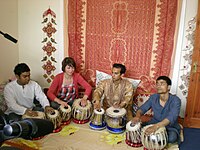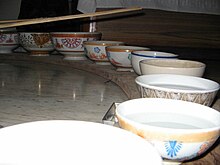
Musical instruments of the Indian subcontinent can be broadly classified according to the Hornbostel–Sachs system into four categories: chordophones (string instruments), aerophones (wind instruments), membranophones (drums) and idiophones (non-drum percussion instruments).
Chordophones[edit]
Plucked strings[edit]
|
Bowed strings[edit]

- Chikara
- Dhantara
- Dilruba
- Ektara violin
- Esraj
- Kamaicha
- Kingri (string instrument)
- Mayuri Vina or Taus
- Onavillu
- Behala (violin type)
- Pena (musical instrument)
- Pinaka vina
- Pulluvan Veena - one stringed violin
- Ravanahatha
- Sarangi
- Classical Sarangi
- Sarinda
- Tar Shehnai
- Taus
- Villu Paatu - arched bow instrument
Other string instruments[edit]
- Gethu or Jhallari – struck tanpura
- Gubguba or Jamuku (khamak)
- Pulluvan kutam
- Santoor – Hammered dulcimer
Aerophones[edit]
Single reed[edit]



Double reed[edit]
Flute[edit]
Bagpipes[edit]
Free reed[edit]
Free reed and bellows[edit]
Brass[edit]
Membranophones[edit]
Hand drums[edit]




|
Hand frame drums[edit]
- Daf, duf, or dafli – medium or large frame drum without jingles, of Persian origin
- Dubki, dimdi or dimri – small frame drum without jingles
- Kanjira – small frame drum with one jingle
- Kansi – small drum without jingles
- Patayani thappu – medium frame drum played with hands
Stick and hand drums[edit]
Stick drums[edit]

- Chande
- Davul
- Kachhi Dhol
- Nagara – pair of kettledrums
- Pambai – unit of two cylindrical drums
- Parai thappu, halgi – frame drum played with two sticks
- Sambal
- Stick daff or stick duff – daff in a stand played with sticks
- Tamak'
- Tasha – type of kettledrum
- Timki
- Urumee
Idiophones[edit]

- Chigggjha – fire tong with brass jingles
- Chengila – metal disc
- Eltathalam
- Gegvrer – brass vessel
- Ghaynti – Northern Indian bell
- Ghatam and Matkam (Earthenware pot drum)
- Ghunyugroo
- Khartal or Chiplya
- Manjira or jhanj or taal
- Nut – clay pot
- Sankarpjlnjang – lithophone
- Thali – metal plate
- Thattukanvjzhi mannai
- Yakshahgana bells
Melodic[edit]

- Jal tarang, ceramic bowls with water
- Kanch tarang, a type of glass harp
- Kashtha tarang, a type of xylophone
Hand harmonium[edit]
Dwarkanath Ghose (Dwarkin) modified the French pedal harmonium.
Electronic[edit]
- Roland HandSonic
- Electronic tanpura
- Electronic (digital) tabla
- Talameter